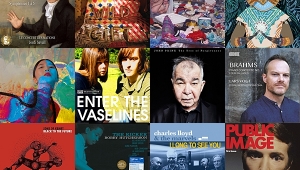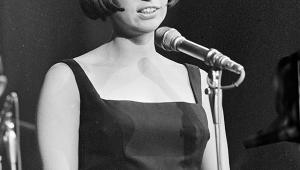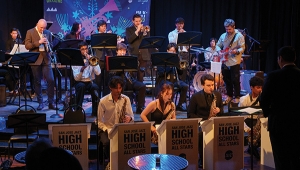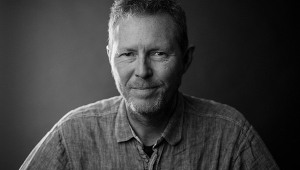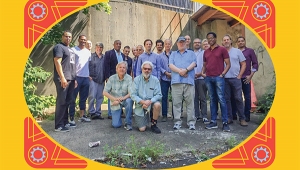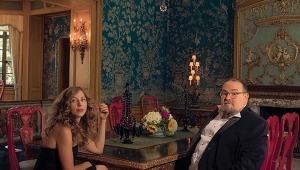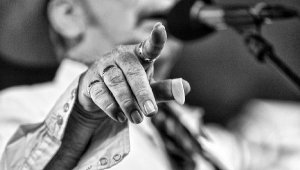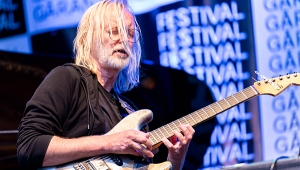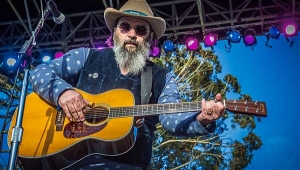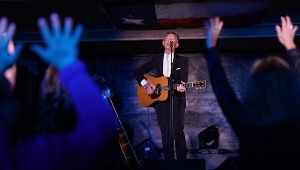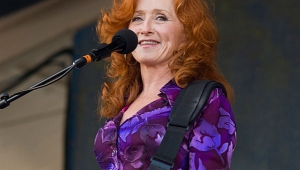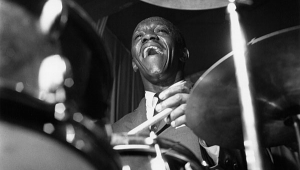| Columns Retired Columns & Blogs |
Attention Screen Takes Flight at Yamaha Live Recording: Documentary or Artifice
Live Recording: Documentary or Artifice
Footnote 1: We will eventually be offering 24-bit/88.2kHz FLAC files of all three Attention Screen albums at HDtracks.com. Visit www.stereophile.com for more information.
I learned my way around a recording studio during my brief career (1972–1976) as a professional bass guitarist, during which time I recorded three albums and some 20 singles with various bands and singers. But I grew increasingly dissatisfied with the conventional practice of overdubbing voices and instruments onto a basic rhythm track until the producer deemed everything perfect. I was redoing my bass part on one session when it dawned on me that even though the notes I was playing fitted better with the overdubs and were technically better played, the organic feel that the drummer and I had created with the original track had been replaced by sterility.
As a result, with the recordings I now create on my own account, I am biased toward the documentary approach. The musicians or singers perform together in the same space, and my job as the engineer is simply to capture their sound in as honest a manner as possible. This, for example, is how I recorded Attention Screen's second Stereophile CD, Live at Otto's Shrunken Head (STPH020-2).
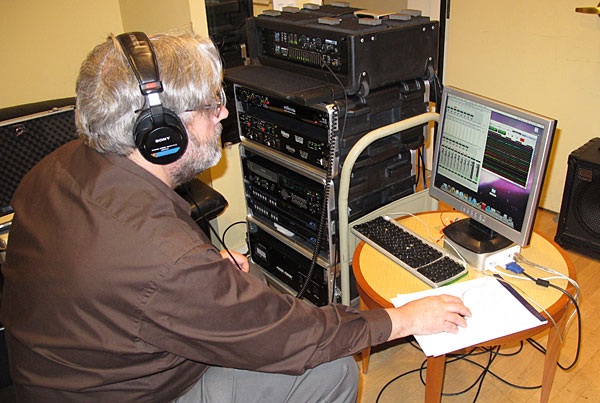
In the perfect hall, which Otto's certainly wasn't—I used two mikes to keep the set-up and load-out times to a minimum—you would need simply to put up a pair of perfect microphones in the perfect place and press Record. But as I have described in previous articles, such honesty can be an elusive target. Halls are never perfect, and even when they come close, finding that perfect position for the microphones is a task that can rarely be completed in the time available. And microphones are even less perfect than halls. As with the photographer's lens, there is no more critical decision when making a recording than choosing which microphones to use. That's why you rarely find used studio-quality microphones offered for sale; engineers never discard a tool that one day, under a new set of circumstances, might prove to be the best choice.
With literal honesty an unattainable goal, engineering thus becomes art, with artifice used to create a recorded sound that can convince listeners that they are present at the live event.
Recording engineer Jim Watson expressed this best on a pro-audio mailing list to which I subscribe: "All recordings are lies. The best recording/mix engineers are the best liars."
I wrote about this paradox at length in the September 2007 issue of Stereophile, explaining how I recorded and mixed Attention Screen's Live at Merkin Hall (Stereophile STPH018-2). Manhattan's Merkin Hall has a beautifully ambient acoustic for a relatively small hall (it seats 400 people), but practical considerations forced me to depart from documentary honesty in that project. I had to mike each instrument individually, as well as use two distant mikes, and, from the resulting 10 tracks, create in the mix my concept of what the listener in the hall's Platonically ideal seat would have heard. Artifice in the service of Art.

Setting up my gear in the Yamaha Artist Services piano salon in midtown Manhattan presented me with a different set of problems, which again worked against a purist approach to capturing the sound of the band, forcing me to tell lies. The salon seats up to 125 people, but is fairly deep and relatively narrow, with a low ceiling. In addition, the low, shallow stage has a vestigial proscenium arch that created some early reflections that confused the imaging. The hall is fitted with Yamaha's Active Field Control sound-reinforcement system, which overlays the basically dry acoustic with synthesized reverberation to give the illusion of a larger performing space. While this worked well for the audience, I was dubious about it offering the same enhancement if I used a single coincident pair of microphones to record the band.
Then there were the issues raised by Yamaha's AvantGrand N3 piano. This purely electronic instrument reproduces the sounds of a sampled Yamaha concert grand, the company's top-model CFIIIS, from an array of four tri-amplified loudspeakers where a conventional grand's soundboard would be and positioned at spots roughly corresponding to where the sampling microphones were placed in the CFIIIS. The N3's hammers strike sensors that play the samples at the pianist's intended volume levels. An adjustable "soundboard resonator" built into the cabinet emulates the resonances of an acoustic piano's soundboard. In addition, Yamaha's Tactile Response System (TRS) uses two transducers in the soundboard to reproduce throughout the entire instrument low-frequency vibrations that can be felt by the player's feet as they rest on the pedals. I thought about taking a direct feed from the instrument as well as miking it, but while it does have stereo output jacks, using these mutes its acoustic output, which would not have been of much use to the rest of the band, let alone the audience.

So, as with the Merkin Hall project, I was going to have to mike each instrument separately and re-create the ideal sonic picture of the event in the mixdown. I dealt with the problem of stage acoustics by moving the piano and drums to the front of the stage, though this gave rise to some problems with the musicians not being able to hear one another as much as they wanted. As the piano projected most of its sound forward to the audience, guitarist Don Fiorino couldn't hear as much of pianist Bob Reina's playing as he needed.
I could, of course, have sent a submix to wedge monitors at the front of the stage, but my experience has been that these overlay live recordings with a fat wodge of mono awfulness. Yamaha had kindly allowed us a full day before the concert for setup and rehearsal—two of the rehearsal improvisations bookend the five concert pieces on the CD—so we experimented with positioning to try to get the best compromise between the competing requirements of recording and performing. I aimed Don's guitar amp, at audience left, diagonally across the stage so that Bob, at audience right, could hear him. I rotated the piano slightly, so that some of its sound reflected off the lid would reach Don.
The miking was basically identical to what I'd used at Merkin. For the piano, I used a pair of Neumann TLM103 solid-state cardioids, about 15" above the AvantGrand's array of speakers. The Neumanns were initially arranged as an ORTF stereo pair (7" apart, angled at 110°), but I ended up pulling them farther apart to give a more even stereo spread from low to high frequencies. For the guitar, I used a single Shure SM57 cardioid, placed about 1" from one of the Fender Vibrolux amplifiers' twin speakers and midway between the dustcap and the surround. For the bass guitar, I took a direct feed from Chris Jones's Trace Elliot bass amp.
I used four microphones for Mark Flynn's drums. An AKG D112 was placed just in front of the kick-drum's front skin, near the felt damping strip, and a tiny Shure Beta 98 capacitor mike was clipped to the snare-drum shell so that its capsule was about 2" above the top skin. These close mikes would give me a good representation of the drums' "body tone," while the snare-drum mike would also capture some of the attack on the hi-hat cymbals. I used a pair of DPA 4011 cardioids as an ORTF pair over the drums, around 3' above the cymbals. This would give good pickup of the cymbals, toms, and snare wires, but also some hall sound, and a stereo picture of the drums that I would use as a backdrop in the mix.

I positioned a spaced pair of Earthworks QTC-40 omnis just in front of the front row of audience seats. These mikes fed the low-noise mike preamps of a Metric Halo ULN-2 two-channel audio interface, and those signals were converted to digital with the ULN-2's 24-bit A/D converters running at 88.2kHz. The ULN-2 was connected via FireWire to a Mac mini computer, which would store the data on its internal hard drive. The other seven mikes and the bass-guitar feed fed a Metric Halo MIO2882+2d, an eight-channel preamp-A/D converter also operating at 24-bits/88.2kHz and slaved to the ULN-2 with an AES/EBU link. The MIO2882 was also connected to the Mac mini via FireWire. Because the MIO2882's mike preamps are not as quiet as the ULN-2's, I used low-noise Millennia Media HV3 mike preamps for the pairs of mikes on the piano and drums.
The 10 channels were recorded as mono AIFF files with the Record Panel of Metric Halo's MIO console. The mixdown to a 32-bit stereo file for each improvisation, with some slight equalization as well as some notching of AC buzz from the guitar amp, was done using Adobe Audition 3 running on a PC. For the mastering, sample-rate conversion, and dithering, I used Bias Peak Pro XT on my MacBook.
Mixdown
The key to a successful mix of a live recording is to echo the musicians' positions on the stage. The basic mix has the piano's stereo image panned from stage center to far right, the stereo drum image covering the full width of the stage, the guitar panned hard left, the bass guitar placed at the center of the stage, and the kick drum a little to the left, where it had been in real life. The snare-drum mike was initially also placed in the center, but I eventually moved it a little to the right of center so that the hi-hat image was appropriately placed in the soundstage.

However, while my first mixes were clean, they were also very dry. The distant audience mikes, fed to the left and right channels, just didn't pick up enough of what little hall ambience there was. While the Merkin Hall acoustic had added a rich warmth to Don's guitar, the instrument sounded one-dimensional in the YASI salon recording. And although Don was using both reverb and repeat-echo effects pedals, his sound resolutely emanated from one position in space.
It was time to step even further away from my purist, documentary approach and tell even bigger lies. I created an additional stereo guitar track using the audience mikes and the spot mike on Don's amplifier. This I treated with some of Adobe Audition's reverb algorithms to mimic those in Don's Boss effects pedals so that, with judicious use of panning and gain riding (both of which can be automated in Adobe Audition's multitrack mixing window), the effect would be to make the images of Don's instruments sound both more solid and more true to what the audience heard live. I did take the liberty, however, of expanding on what had happened at the concert in the second track, "Ear Topology," where Don is already using reverb effects to create washes of sound. What you hear for much of this track is the enhanced stereo version of the guitar track, which adds an element of spaciousness to what Don was playing.
I used a similar philosophy at the climax of "13 Trojans of Vundo" to give the impression that Don's lap steel is both expanding in size and rising in the air as his playing increases in frequency—an especially cool effect with headphones. Everything else that sounds out of the ordinary on this recording, however, stems from Chris Jones's inventive use of his Boss digital delay and Mooger Fooger ring-modulator pedals.
But the mix still sounded very dry. And the dynamic range was extreme, which meant that, too much of the time, the CD would be very quiet. In the mastering, therefore, I used two tools from Metric Halo, implemented in the MIO2882+2d's DSP circuitry and applied to the 24-bit, 88.2kHz two-channel files. First, the processor's Transient Control engine permits gentle and thus virtually undetectable reduction of dynamic range. I used Transient Control as I had on the Otto's Shrunken Head CD, to reduce the transient peaks by 3dB. This allowed me to bring up the average level, hence the album's overall loudness, by the same 3dB. For the recording engineers reading this, my goal was for the album's dynamic range to conform to K-20 on a meter calibrated with the scale developed by Bob Katz, which is typical of audiophile and orchestral mixes.
Second, Metric Halo's Haloverb is one of the better-sounding reverberation algorithms around; I adjusted its parameters to synthesize a room acoustic very similar to that of the YASI salon, but less dry. I used just enough of this synthesized acoustic to add some dimensional modeling to the instrumental images—to glue them together, as it were—but not so much that it would be perceived as audible echo. In effect, while the direct sounds of the instruments were what you would have heard in the front row of audience seats that night in April 2010, the balance between those direct sounds and the hall ambience would be what you would have heard a few rows farther back. The best of both worlds. Artifice in the service of Art.
You can buy Attention Screen's Live at the Yamaha Piano Salon CD from our online shop, with 24-bit/88.2kHz FLAC files eventually available as downloads. I hope you enjoy listening to the music as much as the sold-out audience did.—John Atkinson
Footnote 1: We will eventually be offering 24-bit/88.2kHz FLAC files of all three Attention Screen albums at HDtracks.com. Visit www.stereophile.com for more information.
- Log in or register to post comments
